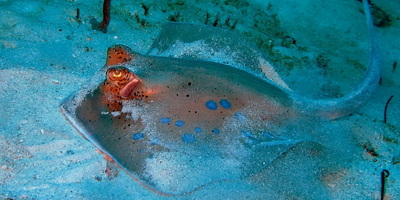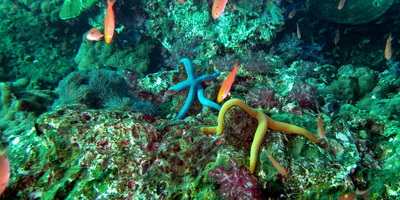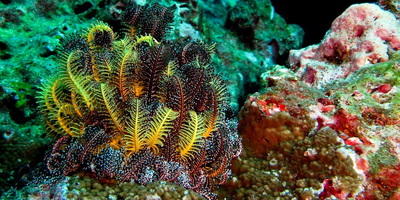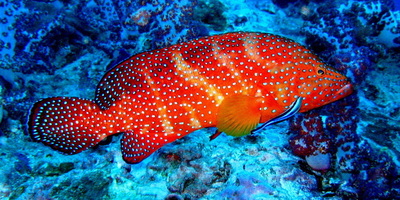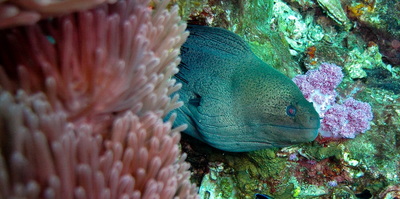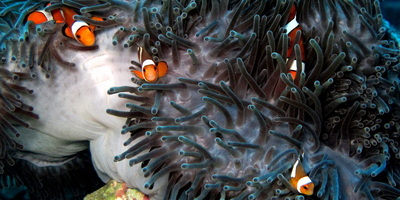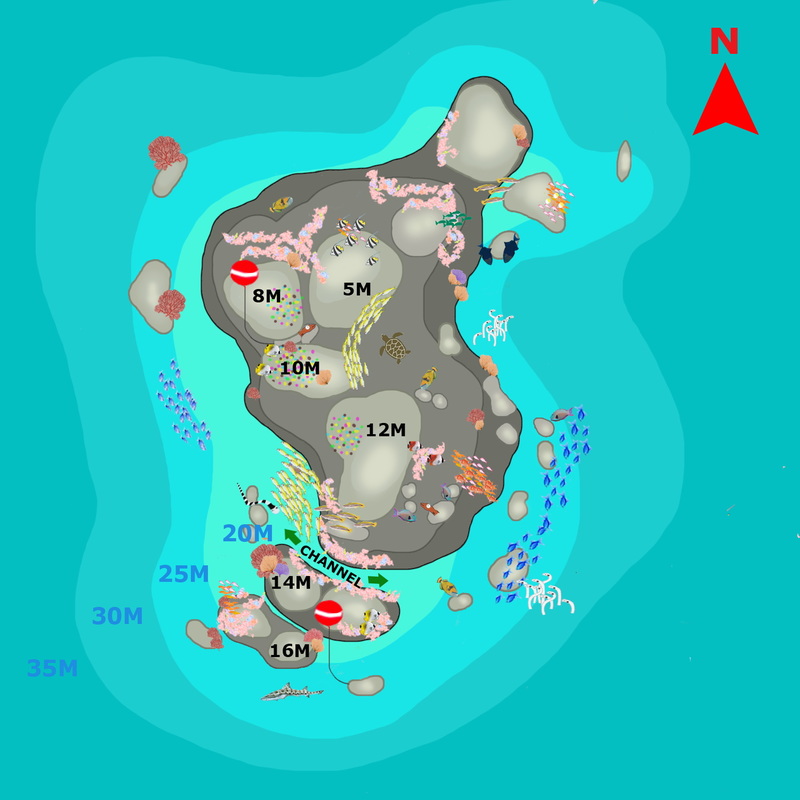Phuket Dive Guide : Anemone reef
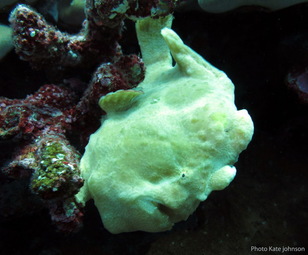
About the location and site
Anemone Reef is located about 600 metres north of Shark Point Marine Sanctuary. The Thai name this beautiful site ‘Hin Jom’ that means 'submerged rock'. This huge limestone pinnacle rises 30 metres up from the seafloor with the tip around 5 metres beneath the surface. It is now 3 metres deeper than it was before the King Cruiser ferry struck it and sheared off the very top of the rock. In shallower areas, this submerged reef is fully covered in extensive fields of gorgeous blue and green sea anemones, hence its name. The soft coral clings to every conceivable surface and gently sway in the current creating the illusion that the giant rock is alive. As expected there are plenty of colourful anemone fish and clownfish living and hiding among the anemones that make great photo opportunities. The site is an absolute treasure trove of macro life.
Anemone Reef is located about 600 metres north of Shark Point Marine Sanctuary. The Thai name this beautiful site ‘Hin Jom’ that means 'submerged rock'. This huge limestone pinnacle rises 30 metres up from the seafloor with the tip around 5 metres beneath the surface. It is now 3 metres deeper than it was before the King Cruiser ferry struck it and sheared off the very top of the rock. In shallower areas, this submerged reef is fully covered in extensive fields of gorgeous blue and green sea anemones, hence its name. The soft coral clings to every conceivable surface and gently sway in the current creating the illusion that the giant rock is alive. As expected there are plenty of colourful anemone fish and clownfish living and hiding among the anemones that make great photo opportunities. The site is an absolute treasure trove of macro life.
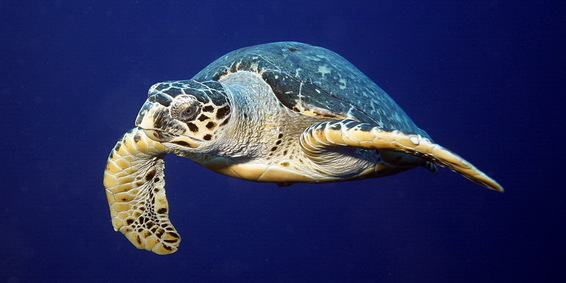
The dive usually begins with a descent to the bottom of the pinnacle from where you can then slowly circle your way up the pinnacle. Currents can be strong here at times so it is advised to navigate the reef by zigzagging to avoid swimming against the current.
The nutrient-rich water and the anemones are a magnet to a vast array of reef fish found feeding or taking shelter. Red-tailed butterflyfish, bannerfish, Moorish idols, trumpet fish, cornetfish and parrotfish are all common here as at the other Phuket dive sites. Large schools of snapper, grouper and fusiliers, as well as soldierfish congregate together in the crevices. The pinnacle's eastern slope is covered in huge lemon sea fans. Look closely as they provide a safe haven for smaller critters such as the yellow tiger-tail seahorses. You can spot them at the deeper levels of the site but it takes a good eye and patience! Anemone Reef is also home to 5 different species of moray eel (giant morays, undulated and white-eyed moray eels as well as the odd honeycomb moray eel) and at least 6 different species of shrimp. Nudibranchs are common here as well. Oriental sweetlips and harlequin sweetlips can also be seen under the corals and you may even be lucky enough to see the exquisite juvenile harlequin sweetlips.
Anemone Reef is also a well-known site for common and spotfin lionfish, sometimes encountered in-groups of up to 10. You can see them gliding about in the open or resting in the barrel sponges away from the current. The barrel sponges dot the lower slopes, and you can sometimes find large bearded scorpionfish resting inside them too. Away from the barrel rims, these fish are often difficult to spot, as they are able to change their skin colour and markings to blend perfectly in with the granite rocks that they rest upon.
In the shallower parts of the dive, look in and around the anemones for their residents skunk, pink, Clark's and tomato anemonefish, among others. However, they are not the only creatures to inhabit the anemones; porcelain crabs can be seen hiding here along with shrimps. Damselfish such as the threespot dascyllus are also seen everywhere.
Anemone Reef's proximity to Shark Point means you are likely to see harmless leopard shark passing by, also larger game fish like tuna and barracuda. You may even spot a hawksbill turtle that is frequently seen here and on the King Cruiser Wreck.
Due to the size and shape of Anemone Reef, it is not recommended to dive it in a strong current, as there are few places to hide without being “trapped” on one side of the rock.
The nutrient-rich water and the anemones are a magnet to a vast array of reef fish found feeding or taking shelter. Red-tailed butterflyfish, bannerfish, Moorish idols, trumpet fish, cornetfish and parrotfish are all common here as at the other Phuket dive sites. Large schools of snapper, grouper and fusiliers, as well as soldierfish congregate together in the crevices. The pinnacle's eastern slope is covered in huge lemon sea fans. Look closely as they provide a safe haven for smaller critters such as the yellow tiger-tail seahorses. You can spot them at the deeper levels of the site but it takes a good eye and patience! Anemone Reef is also home to 5 different species of moray eel (giant morays, undulated and white-eyed moray eels as well as the odd honeycomb moray eel) and at least 6 different species of shrimp. Nudibranchs are common here as well. Oriental sweetlips and harlequin sweetlips can also be seen under the corals and you may even be lucky enough to see the exquisite juvenile harlequin sweetlips.
Anemone Reef is also a well-known site for common and spotfin lionfish, sometimes encountered in-groups of up to 10. You can see them gliding about in the open or resting in the barrel sponges away from the current. The barrel sponges dot the lower slopes, and you can sometimes find large bearded scorpionfish resting inside them too. Away from the barrel rims, these fish are often difficult to spot, as they are able to change their skin colour and markings to blend perfectly in with the granite rocks that they rest upon.
In the shallower parts of the dive, look in and around the anemones for their residents skunk, pink, Clark's and tomato anemonefish, among others. However, they are not the only creatures to inhabit the anemones; porcelain crabs can be seen hiding here along with shrimps. Damselfish such as the threespot dascyllus are also seen everywhere.
Anemone Reef's proximity to Shark Point means you are likely to see harmless leopard shark passing by, also larger game fish like tuna and barracuda. You may even spot a hawksbill turtle that is frequently seen here and on the King Cruiser Wreck.
Due to the size and shape of Anemone Reef, it is not recommended to dive it in a strong current, as there are few places to hide without being “trapped” on one side of the rock.
